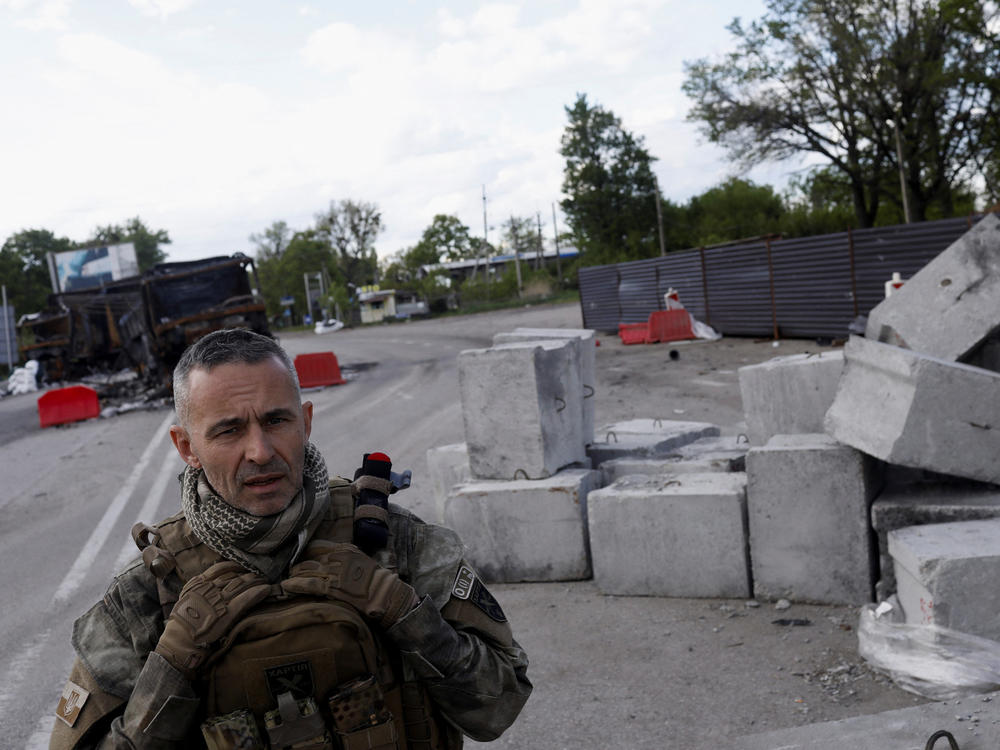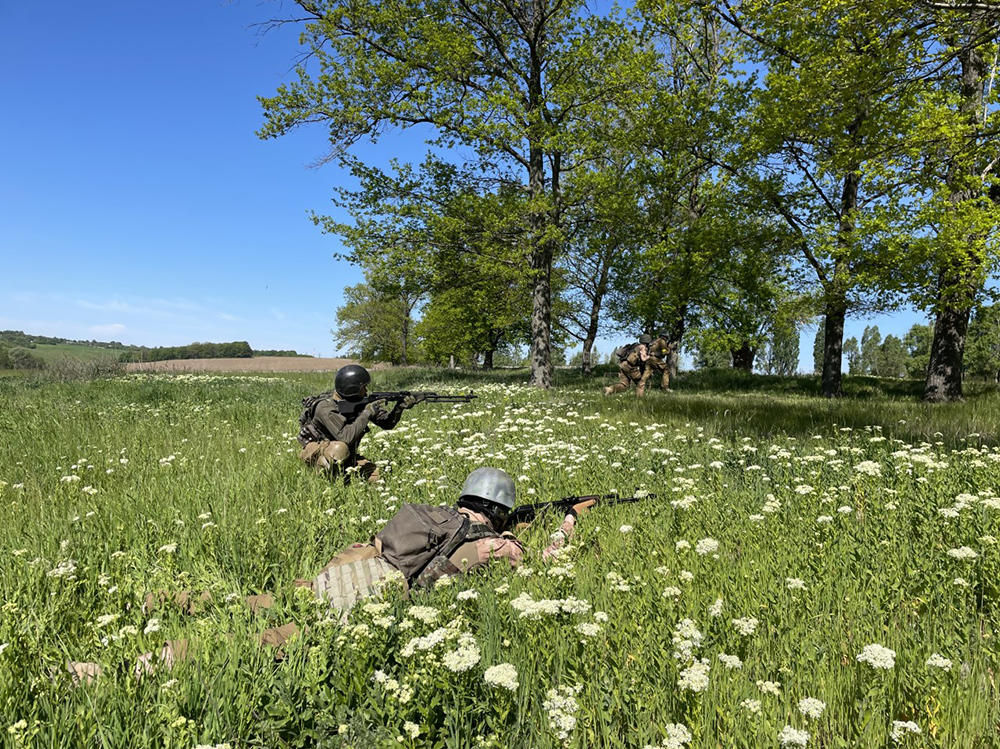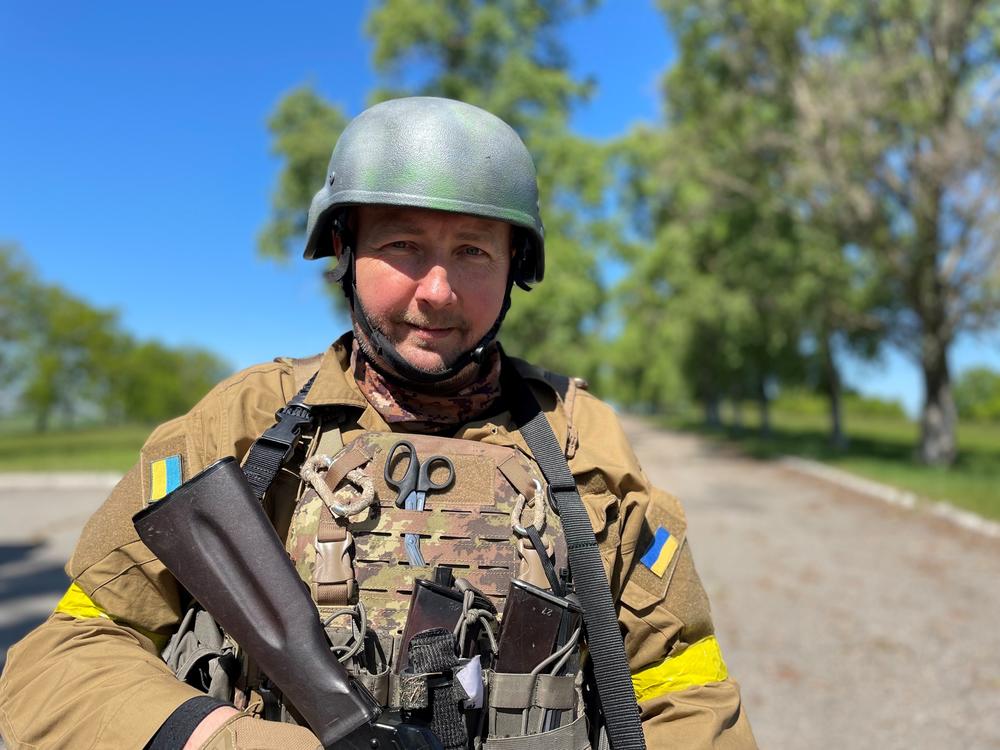Section Branding
Header Content
A look inside the Ukrainian 'billionaire's battalion' fighting Russian forces
Primary Content
Updated June 1, 2022 at 7:02 AM ET
KHARKIV, Ukraine — One of Ukraine's wealthiest men is seated at a white piano in the lobby of a closed-down hotel in Ukraine's second-largest city. The multistory atrium is dark except for a few running lights along the edge of the carpet. Cardboard covers all the windows.
Wearing military fatigues, Vsevolod Kozhemyako is alone at the piano near the elevators, playing a slow, mournful rendition of Beethoven's Für Elise. The notes seep into the cavernous space.
Kozhemyako is the founder and CEO of Agrotrade Group, one of Ukraine's largest grain production, storage and export companies. But his focus is now on the war.
"Yes, I'm a businessman," he says. "And now I'm a commander of a military unit in Ukraine."
Kozhemyako set up and leads his own light infantry battalion. It's formally known as Khartia or "charter," and consists mostly of civilians. It's casually called the "billionaire's battalion," referring to Kozhemyako's wealth in Ukrainian currency, not dollars. Along with other wealthy Ukrainians, Kozhemyako pays for training, weapons and vehicles. His unit takes orders from the army but operates independently.
From yachting to fighting
At 52, Kozhemyako has the lean physique of a long-distance runner. In 2017, he ran the New York City Marathon in less than 3 1/2 hours.
He is known for his taste in fine suits and passion for the outdoors. His prewar Instagram page is populated with shots of Swiss and Austrian ski vacations and cruising on yachts. Forbes Ukraine notes that the father of four skis, runs, bikes, golfs, all while managing tens of thousands of acres of farmland and a staff of 1,500.
Now he also has the furrowed brow and no-nonsense glare of a military commander in wartime.
For weeks on end, Russian ground forces had been shelling Kharkiv with mortars and artillery. The siege destroyed hundreds of buildings, forced hundreds of thousands to flee and brought life to a standstill.
In the midday darkness of the hotel lobby, Kozhemyako describes how his unit — along with the regular Ukrainian military — is part of a counteroffensive to push Russian forces away from Kharkiv.
"I just came from Ruska Lozova," he says of a town on the front line a few miles north of Kharkiv. "There was heavy shelling there. We were sitting without the possibility to leave the village. It's [the Khartia battalion] actually who are pushing the enemy farther and farther from the city. It's them who made these changes."
The counteroffensive has pushed the Russian troops back to the point where their conventional artillery can no longer hit the center of the city.
"Tonight there were three or four rockets which landed here and there were huge explosions," Kozhemyako says, noting that Russia can still launch long-distance cruise missiles at Kharkiv or anyplace else in Ukraine. "This is what they can do, but they cannot now use normal army artillery."
The Ukrainian counteroffensive north and east of Kharkiv essentially broke the siege of the city. Now people are returning, some businesses are reopening and even the public transit system has started running again on a limited schedule.
Farmers, carpenters and factory workers have signed up for the battalion
Technically, the Khartia battalion is a territorial defense unit, a wartime necessity that will go away when the war is over. Most such units are groups of local men who sit at makeshift, sandbagged roadblocks. After the invasion, the government handed out rifles to many of these volunteers, along with instructions on how to make Molotov cocktails.
Kozhemyako's Khartia battalion is one of these volunteer units, on steroids.
Outside Kharkiv, new recruits are training in lush, green fields dotted with white flowers.
Igor Cornet, who spent nearly two decades in the Ukrainian military, is teaching the recruits how to attack a dug-in enemy position. He retired from the military as a lieutenant colonel before going back to college to study agriculture and eventually working with Kozhemyako at Agrotrade.
"Infantry is infantry!" he says with pride. And his job is to turn a collection of civilians into a light infantry battalion. Some of the men are in their teens, others are pushing 50. They are carpenters, factory workers and mechanics, among other things. Cornet says he even has one economist whom he's training to fight. Most come from the Kharkiv region. Some are from areas currently occupied by the Russians.
"We don't win the war without infantry," Cornet declares. "When the soldiers stay here and say, 'I take this area!' we can say, 'yes, we take this.'"
You can bomb a place as much as you want, he says, but until you can send foot soldiers into the streets, you cannot truly control it.
The recruits are issued body armor, helmets and AK-47s. They use surveillance drones to monitor the battlefield. The unit has its own vehicles, all paid for by Kozhemyako and several other wealthy business people from Kharkiv.
After basic training, anyone who doesn't want to go to the front can quit and go back to their previous life. But that rarely happens, Cornet says, and the strength of these fighters is their motivation.
Before the invasion, 36-year-old Sergei Dubinski was a farmer. He grew wheat, sunflowers and garlic. Now he's going to fight on the front lines. He says he's not afraid of getting killed.
"I have a wife and I have a child," Dubinski says. "I want to be able to protect them. I want to be able to protect my country. So that we are able to do the things we did before the war."
If he doesn't step up to fight against the invasion, "Who else is going to protect us?"
Kozhemyako notes that territorial defense units such as his are only authorized under a special martial law.
"This is a special law for the wartime. As soon as the wartime is finished, we are again civilians," he says. His infantrymen can go back to growing wheat and building houses.
Kozhemyako predicts that this could be a long war. But once it's over, he says, he'll go back to being the jet-setting CEO.
Copyright 2022 NPR. To see more, visit https://www.npr.org.



